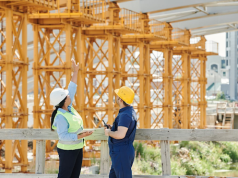Abu Dhabi’s climate places buildings under unusually intense stress, felt most sharply in summer when temperatures rise past 45°C and humidity amplifies the sensation of heat. Long, extreme seasons compress transitional periods, pushing cooling systems to operate almost continuously. As warming trends accelerate, projections indicate steadily increasing cooling demand across Gulf cities, creating operational and environmental pressure on every tower connected to the grid.
When you look at the skyline, it is easy to see architectural ambition; yet behind that ambition sits a daily struggle against heat infiltration, thermal gain and the rising cost of preserving interior comfort.
Ultimately, these conditions translate into elevated energy use, shorter maintenance cycles and the ongoing challenge of balancing comfort with the realities of running energy-intensive systems in a rapidly shifting climate.
Water sources and the cooling paradox
Cooling a tower in Abu Dhabi creates a complex water paradox that becomes clearer when examining the mechanics of district cooling. Abu Dhabi’s Department of Energy estimates that cooling facilities collectively consume around 150,000 cubic meters of desalinated water per day, supporting an overall capacity of roughly 600,000 refrigeration tons.
When you picture a high-rise drawing from this system, such as the visually distinctive Leaf Tower on Al Reem Island, the stakes become tangible. Leaf Tower’s form, designed to resemble overlapping leaves, offers geometry that assists with natural shading, lowering direct solar exposure on key surfaces. Its integration into district cooling places water management at the center of long-term sustainability planning, where modern cooling towers lose water through evaporation, drift and blowdown, requiring careful attention to replenishment and water treatment.
Authorities increasingly promote blended sources that incorporate desalinated water, recycled water and seawater. This approach reduces pressure on freshwater supplies while keeping cooling performance stable.
You encounter the paradox whenever rising temperatures push systems to consume more water, heightening the responsibility to design buildings that use that water more wisely.
Efficiency versus consumption
Engineering a tower for performance in Abu Dhabi’s harsh environment means evaluating every element of design through the lens of thermal behavior and operational efficiency. The challenge appears in façade composition, shading depth, glazing selection and orientation, because each detail affects heat gain and cooling demand.
Meanwhile, research on arid-climate urban morphology shows how dense layouts, low wind flow and high solar exposure elevate cooling loads. These factors intensify the demand placed on mechanical systems, particularly those relying on water-intensive cooling towers. Desalinated water offers predictable quality but ties consumption to energy-heavy production processes, while recycled and seawater options introduce corrosion and scaling risks requiring advanced treatment.
Globally, comparable challenges have encouraged innovative solutions in sustainable tower design. Projects such as Bosco Verticale in Milan, with its vegetated façades that moderate heat or One Central Park in Sydney, which uses heliostat technology and extensive greenery to reduce thermal load, highlight how ecological architecture can meaningfully reduce cooling intensity. When you compare these global examples to Abu Dhabi’s context, you see how sustainability strategies can be adapted, scaled and refined to suit extreme climates.
Today, the dilemma becomes a long-term balance between efficiency, water use, capital investment and the temperature-driven realities of Gulf living.
Policy responses and innovation
Abu Dhabi continues to update its regulatory framework to help you manage these complexities more intelligently, particularly through policies governing water selection and discharge for district cooling plants. The current guidelines allow operators to evaluate recycled water, seawater and other alternative sources based on feasibility and environmental impact, expanding flexibility as cooling demand increases with urban growth.
Innovation reinforces these policy measures, where adiabatic pre-cooling systems lower chiller energy consumption through evaporative techniques, while still requiring less water than traditional cooling tower operations. Moreover, architects are also adopting climate-responsive strategies, integrating deep overhangs, double-skin façades and thermal massing to limit solar gain before it reaches interior spaces.
Leaf Tower reflects this global shift toward modern ecological architecture; its geometry promotes shading efficiency, its structural orientation limits unnecessary heat absorption and its integration into environmentally guided district cooling systems contributes to reduced long-term resource consumption. Around the world, similar design philosophies are emerging in projects like The Edge in Amsterdam, recognized for smart energy management and Masdar City in Abu Dhabi, which demonstrates regionally adapted passive-cooling principles and low-carbon strategies.
Ahead of 2030, each project contributes to a growing movement toward towers capable of operating comfortably with less environmental cost.
Broader environmental and social impacts
When you step back and view the city as a system, the relationship between water, cooling and climate becomes a question of environmental resilience. Heavy dependence on desalinated water ties cooling activity to elevated energy demand and emissions, particularly when desalination plants rely on fossil fuels. With thousands of homes and high-rises drawing cooling power daily, cumulative impacts intensify.
Social considerations emerge alongside environmental ones; cooling is essential in Abu Dhabi’s climate, and any rise in the cost of water or electricity affects residents directly, especially those in older buildings lacking modern efficiency standards. Therefore, coordinated action among developers, regulators, utility operators and urban planners becomes central to improving long-term sustainability outcomes.
Looking ahead: Resilience and adaptation
A more resilient Abu Dhabi depends on embracing technological adaptation and diverse water strategies. As temperature extremes become more frequent, cooling networks will increasingly rely on alternative water sources, smarter distribution systems and buildings designed to moderate heat loads before they reach mechanical equipment.
Blended-water strategies provide a practical way to reduce pressure on desalination, while high-performance façades, heat-reflective materials and strategic orientations help keep interiors cooler with fewer resource demands. Hybrid systems combining mechanical, evaporative and passive techniques may gain traction as developers experiment with more efficient paths.
What becomes clear is that the sustainability of towers such as Leaf Tower is now defined by an integrated philosophy shared with global leaders in ecological architecture; the more holistically water, cooling and climate are addressed, the more balanced and resilient Abu Dhabi’s future skyline becomes.














